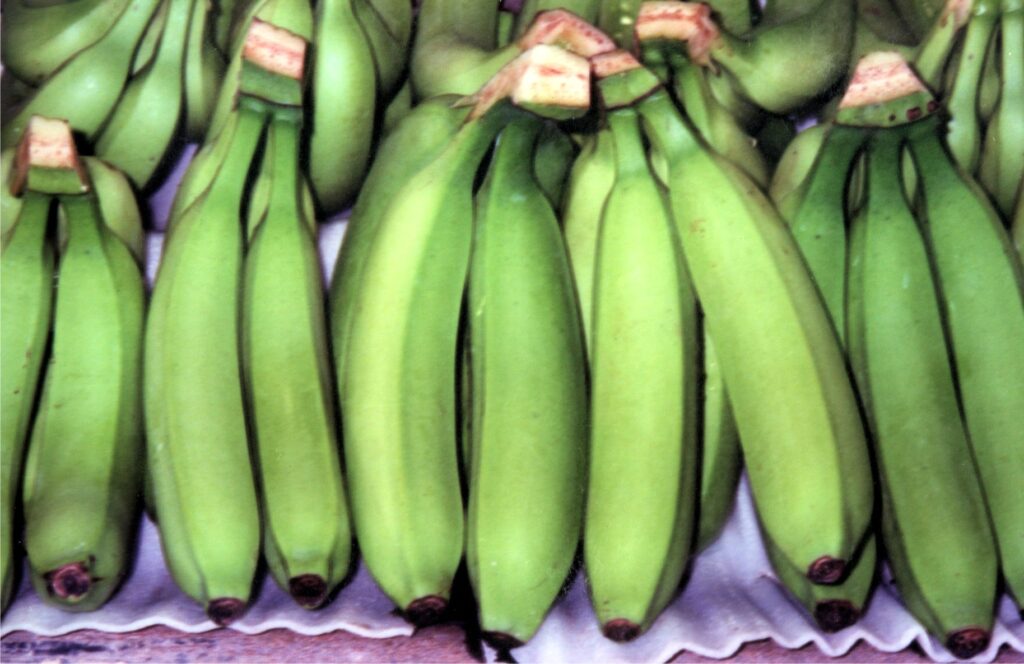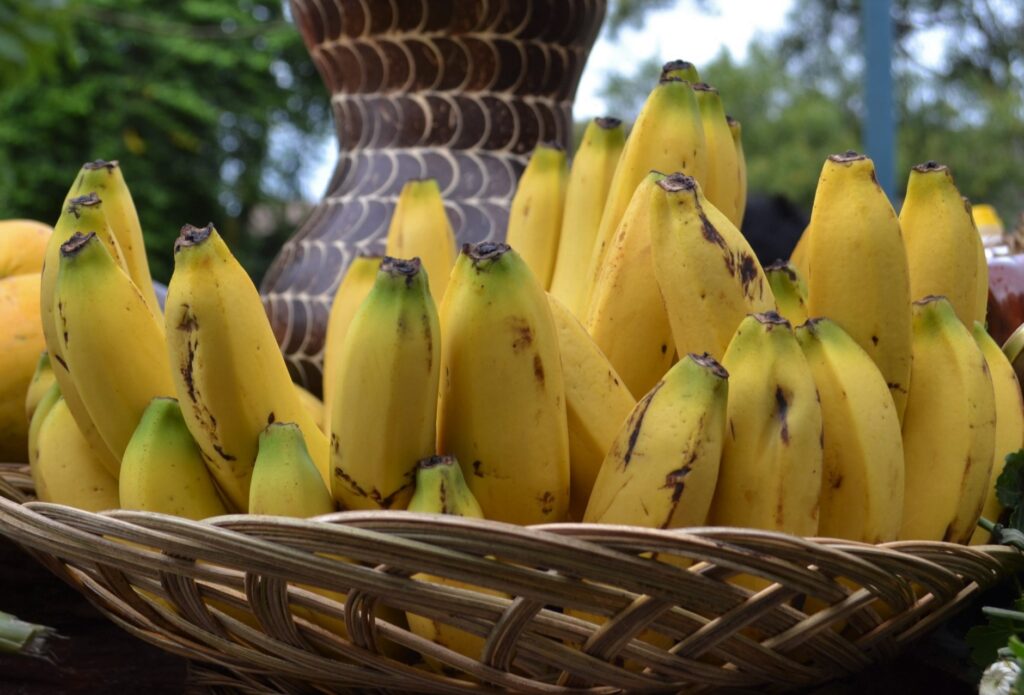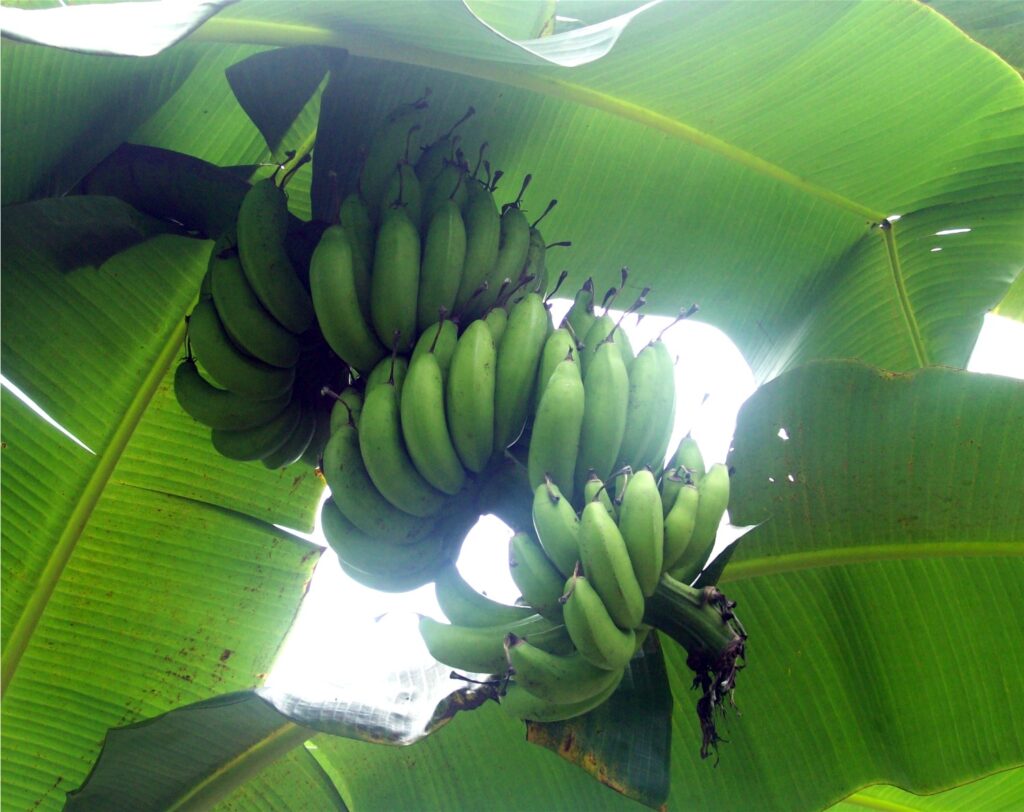Written by Henrylito D. Tacio
If there is a tropical fruit that can be considered as a counterpart of temperate’s apple, then it’s banana. After all, most of the parts of the fruit – and even the leaves – have been found to have multifarious uses.
In popular culture and commerce, “banana” usually refers to soft, sweet “dessert” bananas that are usually eaten raw. The bananas from a group of cultivars with firmer, starchier fruit are called plantains, and are generally used in cooking rather than eaten raw. The word “banana” is derived from the Arabic word “finger.”
Banana is one of the most healthful fruits the world has known. Alexander the Great was so fascinated by the virtues of this fruit that he described it as “the heavenly fruit that tastes like nectar sweetened in honey.”

Health experts claim that bananas are low in protein, free of fats but high in energy. A fully ripe banana has 20-25 percent sugar. It has significant amounts of B-vitamins, especially B1 and B6. B1 is a brain tonic whereas B6 relieves, in particular, uncomfortable symptoms of the pre-menstrual tension syndrome like irritability, headaches, tender breasts, and water retention.
According to a recent survey undertaken in the United States among people suffering from depression, many felt much better after eating a banana. This is because bananas contain tryptophan, a type of protein that the body converts into serotonin, known to make you relax, improve your mood and generally make you feel happier.
“One medium-sized banana boasts of 100-125 kilo calories, 4-5 grams fiber, about 400 milligrams potassium, 17 milligrams calcium, 36 milligrams phosphorus and traces of other minerals like iron,” said Professor Kanwar, an eminent biophysicist who writes for the Health Tribune.
By the way, when you compare banana to an apple, banana has four times the protein, twice the carbohydrate, three times the phosphorus, five times the vitamin A and iron, and twice the other vitamins and minerals. Perhaps, it is high time to change that well-known American phrase to “A banana a day keeps the doctor away.”
Aside from coconut, banana can be considered as “the tree of life.” Dondon Carlo P. Lejano, in an article which appeared in the quarterly publication of Bureau of Agricultural Research, wrote: “Aside from being eaten fresh, the ripe fruit can also be processed into jam, candies, and purees. On the other hand, the unripe bananas may be processed into starch and chips. Banana extracts can also be processed into wine, catsup and vinegar.”
Banana features prominently in Philippine cuisine, being part of traditional dishes and desserts like maruya, turon, and halo-halo. Most of these dishes use the saba or cardaba banana cultivar.
Banana hearts are used as a vegetable in South Asian and Southeast Asian cuisine, either raw or steamed with dips or cooked in soups, curries and fried foods. The flavor resembles that of artichoke. As with artichokes, both the fleshy part of the bracts and the heart are edible.
The banana leaves have their uses, too. The leaves are large, flexible, and waterproof; they are used in many ways, including as umbrellas and to wrap food for cooking, carrying and packing cooked foods. In south India, food is traditionally served on banana leaves in homes and some restaurants also follow the practice.

The banana plant has long been a source of fiber for high quality textiles. In Japan, banana cultivation for clothing and household use dates back to at least the 13th century. In the Japanese system, leaves and shoots are cut from the plant periodically to ensure softness. Harvested shoots are first boiled in lye to prepare fibers for yarn-making.
History records showed bananas were mentioned for the first time in written history in Buddhist texts in 600 BC. Alexander the Great discovered the taste of the banana in the valleys of India in 327 BC. The existence of an organized banana plantation could be found in China in 200 AD. In 650 AD, Islamic conquerors brought the banana to Palestine. In the Middle Ages, both Moslems and Christians thought that the banana was the forbidden fruit of paradise.
Today, bananas are one of the most popular fruits around the world. Bananas are grown in 132 countries worldwide, more than any other fruit crop. India leads in global banana production, representing approximately 23 percent of the worldwide crop but most are consumed domestically. In Asia, bananas are also grown in Indonesia, China, Malaysia, the Philippines, and Thailand, among others.
In the Philippines, bananas are grown mostly in Mindanao, where a total land area of 208,190 hectares is planted to the crop. Luzon has a total of 123,594 hectares devoted to bananas, while Visayas has 85,971 hectares.
There are several kinds of bananas grown in the country but the most popular ones are the latundan, lakatan, and saba. These are mostly grown in the backyard or as a component in an intercropping scheme with minimum care and management. Cavendish is the export variety grown by commercial banana plantations in southern Philippines, particularly in Davao.
“Banana is the prime fruit commodity of the country in terms of area planted and commercial value. It is our most economically important fruit crop and the only locally grown fruit available year-round,” said the editorial of the PCARRD Farm News, published by the Laguna-based Philippine Council for Agriculture, Aquatic and Natural Resources Research and Development (PCAARRD).
Unfortunately, the fruit is on a crash course toward extinction. “Not all is well with our bananas…” said a policy briefing issued by the PCAARRD. “The world today is endangered with the banana apocalypse – the emergence and evolution of the dreadful banana bunchy top (BBT), banana streak, banana bract mosaic, and fusarium wilt,” the policy briefing warned.
“In the Philippines, BBT remained in most farms that brought considerable damages to prime banana-producing provinces in the country,” it added. “Diseases have even evolved and multiplied, which created new banana monsters, such as the black sigatoka, bugtok, moko, and other infectious diseases of quarantine concern.”
Among these diseases, the most common is sigatoka. Caused by fungi, it dries off the leaf surface. The disease is spread in two ways: by water (which carries the conidia or asexual form of reproduction) from the upper to the lower leaves and suckers and by wind (which carries the ascospores or sexual form of reproduction) in all directions.
There are actually two forms: black and yellow sigatoka. “The symptoms of black sigatoka are sometimes not distinguishable from those of yellow sigatoka, especially in the advanced stages of necrosis, which are very similar,” said a website. “The difference is however evident at the early stages of evolution.”
At first, small whitish spots are only visible on the lower surface of the leaf. Then, brown rusty streaks are visible especially at the lower surface. From there, brown streaks lengthen and widen. From brown, it turns to black, round or elliptical broad stripes.

The lesions then become black, usually surrounded by a yellow halo. In the last stage, the center of the stain dries up with a black halo, itself surrounded by a yellow halo.
“Black sigatoka is more virulent than yellow sigatoka,” the website claims. “Symptoms appear on younger leaves and cause more damage to the foliar system. The economic and environmental consequences are more important: yield losses, reduced shelf life, heavier maintenance tasks (deleafing) and increased plant protection (spraying).”
But there’s good news. Black sigatoka can be corrected by using the ionic copper concentrate (ICC), a fungicide and bactericide. “ICC is a unique mineral based which offers performance at low doses to control and prevent fungal and bacterial plant diseases affecting crops,” explains the EPI Phil, the corporation distributing innovative technological breakthrough products in the market today.
“ICC’s unique formulation is based on the natural anti-microbial properties of mineral ions which are essential for plants,” said EPI Phil, whose mission is to develop and offer options that are excellent quality, effective and eco-friendly. “It is specifically formulated for use to control the diseases affecting plantation crops.”
Studies have shown that ICC can help combat black sigatoka. In addition, ICC has been proven to fight such diseases as finger rot, corm rot and moko on banana and pineapple plantations in the country.
Other products EPI Phil is distributing include Purespray Green (spray oil for scale insect and mealy bug), Xtend (plant oil adjuvant), and Zivion P.

